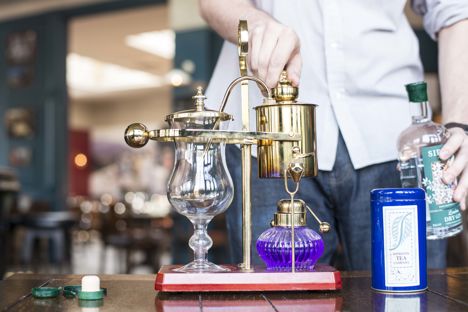
Distilling talent: the transformation of London’s gin scene
It may have been the scourge of the capital in the eighteenth century, but now micro distilleries across London are putting gin back on top. We take a look at how artisan producers are pushing the boundaries of this very British spirit.
Distilling talent: the transformation of London’s gin scene
It may have been the scourge of the capital in the eighteenth century, but now micro distilleries across London are putting gin back on top. We take a look at how artisan producers are pushing the boundaries of this very British spirit.
Until about five years ago, gin wasn’t really seen as the trendy, modern, exciting thing it is today. It was something your mother-in-law might have had a bottle of, collecting dust next to the sherry and crème de menthe. But recent times have paved the way to a sort of gin renaissance – particularly in London – with new micro-distilleries giving the big, industrial producers a run for their money; people now talk about gin in the same way as single malt whisky. Twenty-four new distilleries opened in the UK in 2014, and it looks like a further twenty-five will open by the end of this year. Back in 2009, only four opened. So what’s caused this boom in gin production?
Rags to riches
London has always had a relationship with gin, ever since William of Orange brought it over with him from Holland, where the spirit was first made. By the eighteenth century there was a gin distillery on practically every street in the city, making use of the exotic spices and fruits carried into port. But these were just used to cover up the taste of incredibly poor quality alcohol, being sold on the cheap to everyone in London. This became known as ‘The Gin Craze’ and in 1730 as many as ten million gallons of gin were being distilled each year. It was the root of all sorts of crime and very poor quality, so the government brought in the 1751 Gin Act to put an end to it.
This law put a serious dent in the distilleries’ profits and put moonshiners out of business. Eventually gin production ceased to exist in the capital. It wouldn’t return for nearly 200 years, but over those two centuries, gin underwent a transformation. The spirit changed from a cheap, harsh way of forgetting the troubles of Victorian life into a refined, complex spirit that’s treated with the respect it deserves. In-depth analysis of the botanicals included in a gin’s recipe, the distilling methods used, the provenance of the ingredients and – of course – the stories of the people at the forefront of this new wave of craft gin were becoming increasingly important.
Riding the wave
In 2012 The City of London Distillery brought gin distillation back to the capital after a 200 year hiatus, and in doing so started something big. They were one of the first producers to turn gin into what it is today, experimenting with modern techniques, inventing recipes and playing around with new botanicals. The flavour of gin no longer begins and ends with juniper; there can be exotic notes of liquorice, pink grapefruit, vanilla,cardamom, coriander and rose to name but a few. Instead of giant, industrial tanks churning out gallons of gin a day, there is a more artisanal quality to the process, with beautiful, ornate copper stills (often affectionately named) trickling delicious gin into glass beakers. This is because a lot of these producers started out as a hobby in the back of a cocktail bar or in the corner of a kitchen; they make and sell gin for the love of the craft, nothing more, and have happened to turn it into a profession.
With the rise of the distilleries came the rise of the gin bars – with all those beautifully labelled bottles, it was obvious that bartenders would want to show them off and use them in exciting new ways. While a simple gin and tonic is still the most popular choice, we’ve become more discerning in our tastes. A slice of lemon just doesn’t cut it anymore – cucumber, mint, raspberries, pink peppercorns and even rosemary are all common additions to the classic cocktail. There are countless more adventurous gin-based drinks being shaken and stirred throughout the city, and there are entire clubs, bars and shops dedicated to the rapidly growing world of gin. If you’ve been put off by the flavour in the past and haven’t yet tried something from one of these new distillers, then give it a go – it’s an exciting time for gin, and London’s the perfect place to enjoy it.


